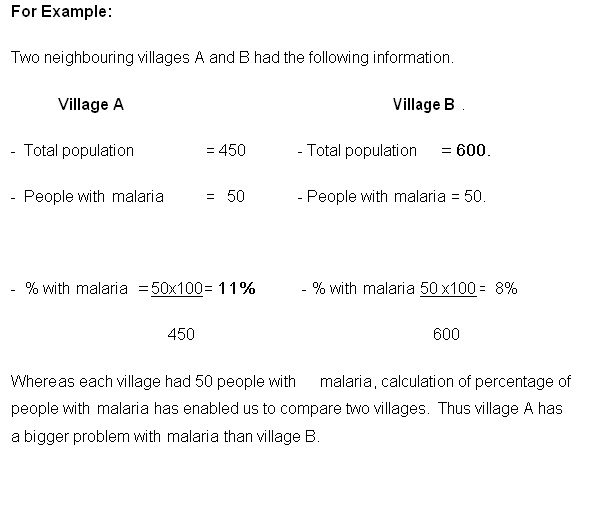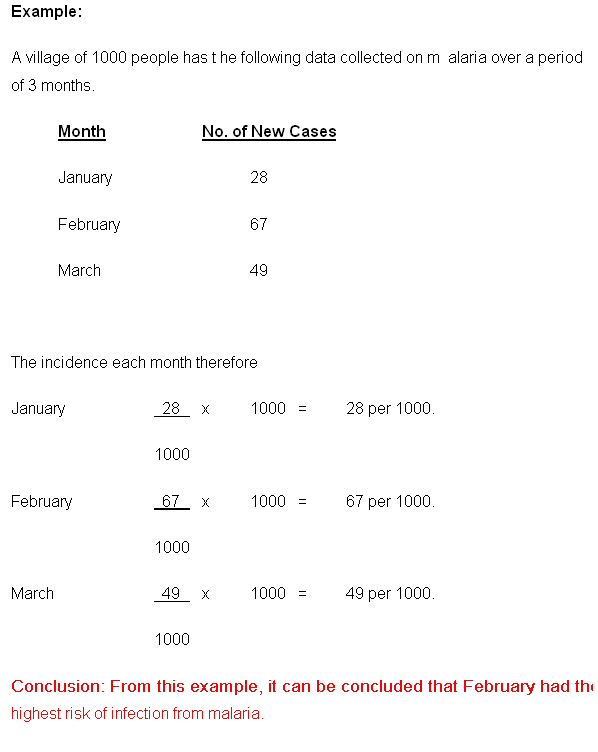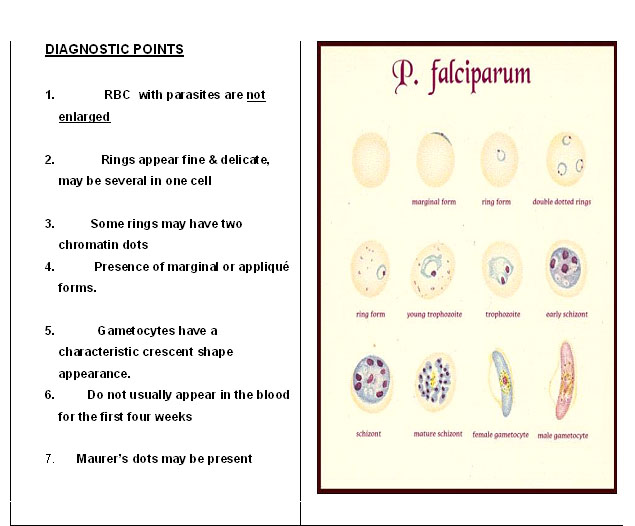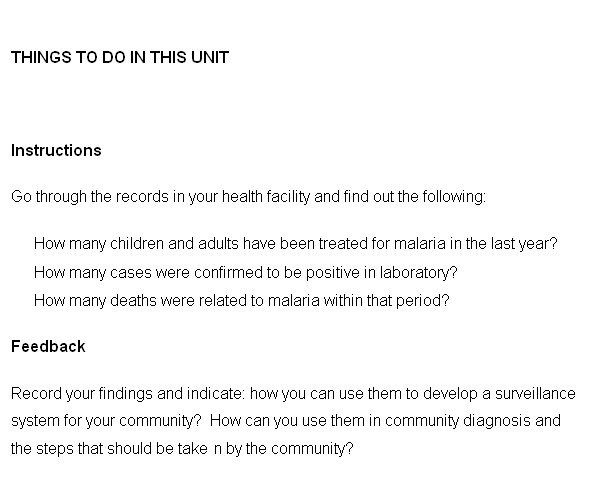Lesson 12: Malaria Surveillance
Contents
- 1 INTRODUCTION
- 1.1 Disease Surveillance in Malaria
- 1.2 Routine surveillance
- 1.3 Community Diagnosis
- 1.4 Investigating Malaria Epidemic
- 1.5 Epidemiological Study
- 1.6 Guidelines in Writing an Epidemiological Study Report.
- 1.7 Role of Laboratory services in Malaria Disease Surveillance
- 1.8 Evaluation of Malaria Control Programmes
- 1.9 CONCLUSION
- 2 Assignment
INTRODUCTION
Welcome to unit 12 on malaria surveillance. In the last Unit we discussed counselling and health promotion in malaria. In this unit we shall look at malaria surveillance. This is the last unit in this course. You are therefore a stone-throw away from completing your course. Congratulations!
So far, much of this course has focused on malaria the disease; its causes and case management. In this unit we shall look at malaria from a different angle – that is surveillance. Surveillance covers aspects of health care related to data collection, reporting of minimum statistics, analysis and presentation of statistical information on malaria.
Because the subject of surveillance is broad, in this unit we shall only consider the following areas of interest:
- Disease surveillance;
- community diagnosis;
- investigation of epidemics;
- carrying out epidemiological study;
- writing and reading reports; and
- The role of laboratory services in malaria surveillance.
Before you proceed let us look at our objectives for this unit.
|
By the end of this unit you should be able to:
|
Disease Surveillance in Malaria
Surveillance is about keeping a careful and CONTINOUS watch over something or somebody. For example, it can mean keeping watch over a suspected a person who has a potential who of committing a violent act.
Before you read on, do Activity 1, it should take you 5 minutes to complete.
Confirm your answer as you read the following:
Surveillance is the continuous collection and analysis of selected health and vital information on events to:
- Identify, investigate and control outbreaks or epidemics;
- Identity specific population groups at high risk of sickness and death from priority diseases;
- Confirm current priorities among disease control activities;
- Evaluate the impact of preventive and curative activities on the incidence and prevalence of priority diseases in the community;
- Monitor disease trends so as to adjust plans to meet current needs.
Surveillance can be divided into three categories:
- Emergency surveillance.
- Active surveillance
- Routine Surveillance
Let us now discuss each one of them in turn.
Emergency (active) surveillance:
The objectives of emergency surveillance include:
- Monitoring the community for cases on diseases of epidemiological importance (e.g. malaria, Meningitis, Ebola);
- Identifying close controls of cases of epidemic potential;
- Acting appropriately when any cases are detected.
Having seen the definition and objectives of emergency surveillance, do Activity 2, it should take you 5 minutes to complete.
| 2
What do you think are the essential steps in carrying out emergency surveillance? ………………………………………………………………………………… …………………………………………………………………………………… …………………………………………………………………………………… …………………………………………………………………………………… …………………………………………………………………………………… …………………………………………………………………………………… ……………………………………………………………………………………
|
Confirm your answer as you read the following:
You should take the following steps when establishing emergency surveillance:
- Establish accurate record keeping;
- Identify someone to designate as the person in charge of surveillance and give them the authority to act;
- Watch all links in the chain of infection. In this step consider the following
- The aetiological organism
- Its reservoir
- Its method of transmission
- The at risk and vulnerable population
Routine surveillance
In routine surveillance, data is assembled through existing methods of routine reporting.
Routine surveillance can either be active or passive. Let us briefly consider each in turn;
Active routine surveillance:
In this, surveillance is done all the time by collecting data in your health unit or laboratory, for example, routine reporting on blood film for malaria parasite.
Passive routine surveillance:
This uses already existing systems in your districts. It relies on the periodic reports you prepare and submit to your district team. That is why these reports should be as accurate and detailed as possible.
We had earlier mentioned that surveillance should lead to action. Some of the Actions include the following:
- Identifying areas which have a higher prevalence of malaria disease than others;
- Identifying the need for further health services;
- Evidence-based health care planning;
- Identifying areas that need immediate decisive intervention;
- Dissemination of data to other districts and persons/organizations;
- Health education.
Having looked at the what surveillance is and the actions that should be taken, let us turn to the uses of disease surveillances in reference to malaria.
Uses of disease surveillance
Before you read on, do Activity 3, it should take you 5 minutes to complete.
| 3
Why should you carry out malaria disease surveillance in your community? ………………………………………………………………………………… …………………………………………………………………………………… …………………………………………………………………………………… …………………………………………………………………………………… …………………………………………………………………………………… …………………………………………………………………………………… ……………………………………………………………………………………
|
We hope your answers included the following reasons for carrying out malaria disease surveillance in the community:
- To make a community diagnosis of malaria at a particular point in time;
- To monitor continuously over a period of time the change in the trend of malaria in the community following interventions;
- To be able to act quickly and so cut short any epidemic or outbreak of malaria;
- To investigate malaria epidemic, analyze the reasons for it, plan a feasible intervention/s, carry out and monitor the effects of the intervention/s on the out break;
- To increase knowledge on the malaria disease dynamics including vector and human reservoir;
- To plan effective health services.
One of the importance of Disease Surveillance is to carry out a community diagnosis. Let us now turn to understand about community diagnosis.
Community Diagnosis
Before you proceed do Activity 4, it should take you 5 minutes to complete.
| 4
1. What do you understand by the term community diagnosis? ………………………………………………………………………………… …………………………………………………………………………………… …………………………………………………………………………………… …………………………………………………………………………………… 2. Outline the steps you would follow when carrying out a community diagnosis in your community. ………………………………………………………………………………… …………………………………………………………………………………… …………………………………………………………………………………… ……………………………………………………………………………………
|
Confirm your answer as you read the following discussion:-
Community diagnosis is a process of establishing which of the local diseases or health problems in a community are important and which ones should be given high priority by the health worker. It is a participatory process that involves the community. In carrying out community diagnosis, you should establish a good relationship with community leaders and involve them in your activities. Your work should always be done with the knowledge and co-operation of community leaders. If this is not done, you may not succeed in achieving your objective.
Community diagnosis answers the following questions:
- What are the commonest diseases seen in out patients?
- What is the distribution of the common diseases in the area?
- What is the local distribution of uncommon but important diseases in the area?
- What diseases have presented in an epidemic form in the area in the past?
- Which diseases are the community most concerned about?
- Which are the most important local health problems?
The following steps form the backbone of a community diagnosis exercise:
- Identify the sources of data about the community and it’s health;
- Assess the reliability of the data available and their limitations;
- Collect data about the characteristics of the population;
- Relate individual’s health and malaria infection in your community to their places of residence and season of the year;
- Establish birth rates and death rates in your community.
We shall now turn to investigating malaria epidemic.
Investigating Malaria Epidemic
In this section we shall look at the measurement of disease factors in the community with special emphasis on malaria.
The incidence and prevalence of malaria in the community helps us to define the extent of malaria problem in that community.
Effective surveillance systems are essential for the control and prevention of malaria disease. The following steps are vital in investigating malaria epidemics:
- Counting the disease events and describing them in appropriate terms;
- Estimating the degree of risk related to a factor affecting the health of the community or a group of individuals affected;
- Identifying why the malaria cases have gone out of expected proportion;
- Identifying ways of controlling the epidemic outbreak
- Mounting a programme of surveillance, either as an emergency or as a routine.
Having learnt the steps in carrying out an investigation of an epidemic, let us now look at epidemiological study.
Epidemiological Study
This is a very broad subject. For purposes of this unit, we shall only consider how to plan an epidemiological study.
Before you read on do activity 5, it should take you 5 minutes to complete.
| 5
List down three main steps in the planning of an epidemiological study. ………………………………………………………………………………… …………………………………………………………………………………… …………………………………………………………………………………… …………………………………………………………………………………… …………………………………………………………………………………… …………………………………………………………………………………… ……………………………………………………………………………………
|
Confirm your answer as you read the following discussion.
There are three main steps in the planning of an epidemiological study. These are:
- Deciding whether an investigation is needed;
- Deciding what methods are to be used;
- Deciding what resources are needed.
After you have got satisfactory answers to all the above questions, you then do the following:
- Set the objectives appropriate to the purpose of the investigations;
- Select a study design appropriate to the investigation;
- Choose a study population and appropriate method of sampling it;
- Determine what background information, resources and administrative procedures are needed in order to carrying out the investigation.
At this stage, you are now ready to carry out data collection. Let us look at how this is done.
Collection and reporting of minimal statistical information on Malaria
You can collect various types of information at various levels of health services from:-
- Records in health facilities
- Special reports.
When information (Data) is collected, it has a lot of uses in our day-to-day life, especially for planning purposes and to give early warning signs of increasing disease trends.
In the case of malaria, the following is the priority information we should collect:
- Number of malaria cases managed at the Out Patient and In-Patient.
- Type and amount of treatment given.
- Rate of confirmed positive cases
- Number of referrals and reasons.
Before you read on, do Activity 6, it should take you 5 minutes to complete.
I hope in your answer you indicated the following uses to which you can put the data you collect on malaria:
- Setting objectives and priorities;
- Monitoring and delivering health service including drug utilization;
- Evaluation of health programme;
- Teaching purpose;
- Operational control of health services;
- Planning health policies and strategies;
- Recognizing abnormal situations and taking remedial action.
Each activity is a potential source of information that can be reported through the following means:
- Use of forms;
- Use of special studies;
- Any other ad hoc means.
Before you read on do Activity 7, it should take you 5 minutes to complete.
You can collect data on malaria from the following sources:
- Records at health facilities;
- Laboratories attached to health facilities;
- Village and community workers;
- Private health care clinics;
- Surveys in the community especially among school children;
- Death certificates.
You can collect and analyze data to portray important differences, which the health services providers should be aware about. Changes observed over time may reflect unusual events that may call for changes in current policies.
All malaria cases diagnosed should be recorded daily according to age, sex, and type of malaria. The data should be summarized on a monthly record form. This data should be regularly analyzed and used as already outlined above.
Analysis and interpretation of statistical information on Malaria
- Data on malaria collected from various sources should always be analyzed and interpreted so that appropriate action can be taken. It is therefore important for health workers at the periphery who collect the data to learn basic methods of data analysis and interpretation and to be able to act accordingly.
Definition and calculation of various vital statistical indicators
a) Range
- It is defined as the difference between the largest and smallest figure of a set of values. To determine the range, we re-arrange figures in ascending order and deduct the lowest from the highest figure. The range is useful in showing the dispersion or variation of the values in question. E.g. variation age, weight etc.
b) Arithmetic mean
- It is the sum of all values of a set of observations divided by the number of observations.
To determine the arithmetic mean we calculate the sum of all the observations and divide it by the total number of observations. Arithmetic mean gives us the average value of the observations.
c) Percentage
- It is a number of observations in a group with a particular characteristic divided by the total number in the group multiplied by 100.
Percentages are used to compare two or more groups with each other.
Such a simple calculation of percentage enables the health worker to establish:
- Which health unit is seeing more malaria cases;
- What is the percentage of malaria in out-patients, in-patients,
- Percentage of malaria deaths compared to other diseases;
- Which age groups form the biggest percentage of malaria cases?
This information would assist the health worker to identify priority areas, age groups and diseases for action, also in evaluating the impact of any control activities.
d) Incidence:
- Incidence of malaria is the number of new cases of malaria occurring during a given period of time in a given population.
An episode of malaria may last for a number of days say 4-7 days. So in calculating incidence, re-attendances must be distinguished from new cases (new episodes). The information can be compiled on daily, weekly and monthly basis. The computation of the incidence of malaria at a health unit or in the community is an important indicator for detecting, monitoring and evaluating malaria epidemics. Malaria incidence computation can help the health worker to identify which parts of the year have the biggest problem and plan accordingly.
Incidence is expressed as a rate per 1000 population.
Incidence Rate = (No. of new cases of malaria x 1000)/Population of community
e) Prevalence: Prevalence of malaria is the number of both new and old cases of malaria found at a particular point in time in a given population.
Prevalent Rate = (No, of new and old cases at particular time x 1000)/Population of community
The prevalence rate can be used to compare the level of malaria burden at a particular time in two or more communities or areas.
Presentation of Data
For data to be more easily appreciated and to draw quick comparisons, it is often useful to arrange the data in the form that can be easily interpreted.
Before you read on do Activity 8, it should take you 5 minutes to complete.
| 8
List down the various methods of presenting data. …………………………………………………………………………………………… …………………………………………………………………………………………… …………………………………………………………………………………………… …………………………………………………………………………………………… …………………………………………………………………………………………… …………………………………………………………………………………………… …………………………………………………………………………………………… ……………………………………………………………………………………………
|
I hope your list included the following ways of presenting data:
- Tabular form (in table).
- Line graph.
- Histogram.
- Bar Chart.
- Pie Chart. e.t.c.
A frequency distribution table helps to put meaning and pattern in raw data. To prepare a frequency distribution table the data must be grouped in classes which can be easily understood and analyzed.
The same data can be presented in form of a histogram, line graph, bar chart or pie chart.
Now that you have learnt how to collect data and report minimum statistics in malaria, let us now consider how to write an epidemiological study report.
Guidelines in Writing an Epidemiological Study Report.
After carrying out your survey or community diagnosis, you need to communicate your findings so that people are aware of what you have done and what action needs to be taken. One way of doing this is by writing a report.
The most difficult part of writing a study report is actually how to start it. Once you have made a start you will find that the task becomes easier.
The main parts for an epidemiological report will be, but not limited to:-
- Title of the report
- Summary of the main objectives , methods of investigation, results and conclusion
- Introduction and Background information ( Based on the problem and published information on the subject)
- Method of investigation, tools and sampling methods
- Results and discussion of results
- Conclusions and recommendations
- References and appendices
Your first aim is to produce a rough draft of your report. This will help clarify your thought about how to express your results and conclusions. Subsequent revisions of your report will be much easier to make.
When you have completed your first draft, discuss your report with your colleagues and your supervisor. Listen to what others have to say.
To be useful, your report should not only give the results of the study and the inferences drawn, but also information about how the study was conducted to enable a critical reader carryout a similar study.
The following are guidelines in writing an epidemiological study report:
- Write in clear, concise and logical manner;
- List the major components of the report;
- Describe the main features of tables and diagrams in relation to the presentation of findings in an epidemiological report;
- Draw accurate diagrams to demonstrate given data;
- List ways in which maps may be used in epidemiological study;
- Describe the major elements to be explained;
- Demonstrate how to deal with each of these elements with reference to a given published paper;
- Critically evaluate the credibility and usefulness of an epidemiological report.
Let us now learn about the role of laboratory services in malaria disease surveillance.
Role of Laboratory services in Malaria Disease Surveillance
In respect to malaria disease, laboratory services play a very important role. Where laboratory services are available and accessible, accurate information can be obtained for effective control and prevention of diseases.
The laboratory service has a role in the following areas:
- Identifying the malaria causing agents;
- Screening population for malaria;
- Validating malaria treatment;
- Monitoring the behaviour of malaria parasites during the epidemics.
Laboratory diagnosis of malaria aims at identifying the various stages in the life cycle of malaria parasite. It is important to note that there are certain stages of the parasite which are critical in deciding the type of interventions for prevention and control of malaria.
Figure 1: Laboratory diagnosis of malaria
|
The laboratory staff should be a member of the health team that investigates an epidemic. |
Evaluation of Malaria Control Programmes
Let us start by looking at the definition of programme evaluation.
Before you read on, do Activity 9, it should take you 5 minutes to complete.
Confirm your answer as you read the following discussion.
Programme evaluation is the systematic collection of programme data its use to improve health programmes and guide the allocation of their resources
Evaluation provides information that is:
• timely: :i.e. available at all times for programme improvement during implementation
• relevant: :i.e. directly related to programme management
• decentralized: :i.e. transmitted rapidly to all levels of the health system
Before you read on, do Activity 10, it should take you 5 minutes to complete.
| 10
Name four interrelated components of evaluation of malaria control programme ………………………………………………………………………………… ………………………………………………………………………………… ………………………………………………………………………………… ………………………………………………………………………………… ………………………………………………………………………………… ………………………………………………………………………………… ………………………………………………………………………………… …………………………………………………………………………………
|
Four interrelated components of evaluation of national malaria control programmes include:
(i) Process monitoring: :to verify whether activities are carried out as planned, to ensure accountability and detect problems
(ii) Evaluation of programme outcomes and impact: :to document that programmes lead to expected results in terms of improved quality of services, rate of coverage, establishing practices etc (outcome targets), and of the desired changes in morbidity and mortality (impact objectives
(iii) Applied research: :can include cost studies and evaluations of effectiveness requiring research designs more rigorous than the tracking of indicators
(iv) Periodic programme evaluation: :to bring together all the information necessary for possible re-planning.
CONCLUSION
We have now come to the end of unit 12. In this unit we discussed surveillance, community diagnosis and investigation of epidemics in relation to malaria. We also learnt that surveillance can be active or routine and that when it is carried out it should always lead to action. Lastly we looked at how to evaluate a malaria control programme.
You should now review the learning objectives given at the beginning of this unit to check if you have achieved all of them. If there is any that you are not sure about go to the relevant section and read it again. If you feel confident that you have learnt the work of this unit, complete the attached Tutor Marked Assignment. Remember to also do the practical assignment given below.
GLOSSARY
APPLIED RESEARCH
HEALTH SURVEILLANCE (HIS)
CASE FATALITY RATE
EVALUATION
FEEDBACK
GOAL
IMPACT
INCIDENCE
INCIDENCE RATE
INDICATOR
MORBIDITY
MORBIDITY RATE
MORTALITY RATE
NOTIFICATION
OUTCOMES
|
|
AMREF DIRECTORATE OF LEARNING SYSTEMS
Student Number: _________________________________ Student Postal Address: __________________________ __________________________
Unit 12: Malaria Surveillance
……………………………………………………………………………… ………………………………………………………………………………… ………………………………………………………………………………… ………………………………………………………………………………… ………………………………………………………………………………… ……………………………………………………………………………………
……………………………………………………………………………… …………………………………………………………………………… ……………………………………………………………………………… ……………………………………………………………………………
…………………………………………………………………………… ………………………………………………………………………… ……………………………………………………………………… ………………………………………………………………………… …………………………………………………………………………… …………………………………………………………………………
…………………………………………………………………………………… …………………………………………………………………………………… …………………………………………………………………………………… …………………………………………………………………………………… …………………………………………………………………………………… …………………………………………………………………………………… 4.What sources of data are available in your community for malaria surveillance? …………………………………………………………………………………… …………………………………………………………………………………… …………………………………………………………………………………… ……………………………………………………………………………………
…………………………………………………………………………… ………………………………………………………………………… ……………………………………………………………………… ………………………………………………………………………… …………………………………………………………………………… ………………………………………………………………………… 6.Write down the definition of programme evaluation ………………………………………………………………………………… …………………………………………………………………………………
………………………………………………………………………… ……………………………………………………………………… ………………………………………………………………………
………………………………………………………………………… ………………………………………………………………………… ………………………………………………………………………… ………………………………………………………………………… Congratulations! You have come to the end of this assignment. If you encountered any problems in this unit please write to us. We shall be happy to give you relevant responses to enable you cope with the course. Ensure that you have written your name, student number and address on the assignment and then send it by post or bring it in person to AMREF. Congratulations! You have also come to the end of this course on malaria. We hope you have learnt a lot and that you are now well equipped to manage, prevent and control malaria in your catchment area. |
We wish you success in your fight against malaria!



